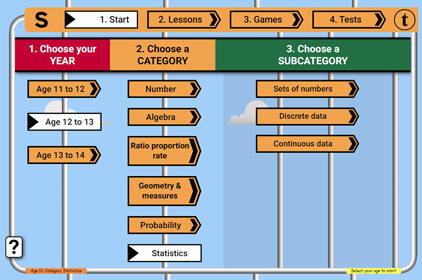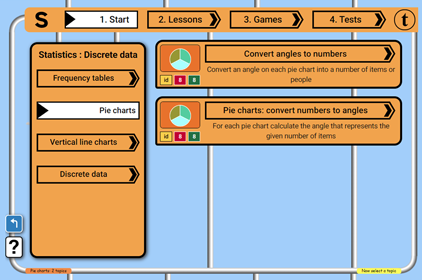


7th grade Geometry & measures topics for Secondary math learners
| Topic icon key | ||
eq | Equation | Each item in the topic is in the form of an equation |
id | Identify | Each item in the topic is a thing |
mi | Missing item | Each item in the topic is a statement with a missing term |
10 | Number of items | There are 10 items in this topic |
8 | Extended items | Additional questions for games and tests in this topic |
Our math topics for 7th grade learners are designed to follow closely the Common Core standards for math for 7th grade pupils.
Geometry & measures syllabus for 7th grade
Here are some key aspects of the math curriculum for geometry and measures for students aged 12 to 13:
Properties of Geometric Figures: Students extend their knowledge of geometric shapes and their properties. They explore the characteristics of triangles, quadrilaterals, and other polygons in more depth. They learn about interior and exterior angles, relationships between angles and sides, and the properties of different types of polygons.
Coordinate Geometry: Students are introduced to coordinate geometry, where they learn to plot and identify points on a coordinate plane. They explore concepts such as ordered pairs, axes, quadrants, and the distance and midpoint formulas. They also learn to represent geometric figures using coordinates.
Pythagorean Theorem: Students study the Pythagorean Theorem and its applications. They learn to identify right triangles and use the theorem to find missing side lengths. They solve problems involving the distance between points on a coordinate plane and explore geometric situations where the theorem is applicable.
Construction and Geometric Constructions: Students learn basic constructions using a compass and straightedge, such as constructing perpendicular bisectors, angle bisectors, and parallel lines. They explore the properties and applications of these constructions, as well as the construction of triangles and other geometric figures.
Similarity and Congruence: Students study similarity and congruence of geometric figures. They learn about corresponding parts of congruent figures and corresponding angles and side ratios of similar figures. They apply these concepts to solve problems involving similarity and congruence.
Surface Area and Volume: Students explore the concepts of surface area and volume of 3D shapes. They learn to calculate the surface area and volume of prisms, cylinders, pyramids, cones, and spheres. They apply these concepts to solve real-world problems involving objects with complex shapes.
Transformational Geometry: Students deepen their understanding of transformations, including translations, reflections, rotations, and dilations. They explore the effects of transformations on geometric figures and apply transformations to solve problems involving symmetry, congruence, and similarity.
Angle Relationships: Students study more advanced angle relationships, including alternate interior, alternate exterior, corresponding, and consecutive interior angles. They explore the properties and theorems related to parallel lines and transversals.
Data Analysis and Probability in Geometry: Students analyze and interpret data using geometric concepts. They use geometric probability to determine the likelihood of events and explore how data can be represented and analyzed using graphs and diagrams.
Geometric Reasoning and Proofs: Students engage in geometric reasoning and proof-based activities. They learn to use deductive reasoning to prove geometric theorems and properties. They apply logical arguments to justify and prove geometric relationships.
Throughout the curriculum, students engage in problem-solving activities, hands-on explorations, and real-world applications to reinforce their understanding of geometry and measurement. They develop their skills in critical thinking, logical reasoning, spatial visualization, and mathematical communication.
A topic is selected at the beginning of a session at Free Math Games and will be remembered when you move between games or activities. The math for the topic is carefully constructed to match the level of difficulty taught in US schools. This means that you as a secondary pupil should see similar math problems to those you are seeing at school (if you are at school) for any particular subject. Please let us know if that is not the case.
See the help box below for instructions on choosing a topic here at Free Math Games.
UXO * Duck shoot * The frog flies * Pong * Cat and mouse * The beetle and the bee
Rock fall * Four in a row * Sow grow * Choose or lose * Mix and match





How to choose a 7th grade Geometry & measures topic for Secondary math

Click on the "1. Start" button in the top navigation bar - that brings you to this Secondary level topic selection page. On the topic selection page you will see that the topics are divided up:
- By level (Preschool, Elementary and Secondary)
- By grade (6th to 8th for this level)
- Into broad categories
Since you are currently within the Secondary section of Free Math Games you will see the Secondary topics. The Secondary grades will have loaded. Choose your grade. The broad categories available will load. Click on a category to see the available sub-categories and topics.

For example, if you choose 7th grade, then the category: "Algebra" and the sub-category "Sequences" you will be offered a choice of sub-sub-categories and topics suitable for your school grade - in the case of this example, "Generating terms" and "nth term expressions". Click on each sub-sub-category to view the available topics.
When you click on the name of a topic, the topic will load into the lesson page (once a topic has loaded it will be available for all activities and will not have to be downloaded again) and the lesson start page will be displayed. You can choose to do the lesson or jump immediately to the games using that topic.










